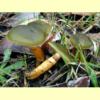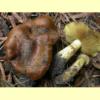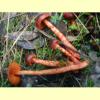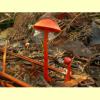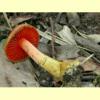
images/Cortinarius_subgenus_Dermocybe/Dermocybe_austr.jpg
Small to large agaric, growing on the ground, with a rusty to ochre-brown or sometimes clay-brown spore print. Pileus often brightly coloured orange, red, yellow or green, but also brown or black; surface smooth or radially fibrillose, dry or moist or rarely viscid. Lamellae adnexed, adnate, sinuate or notched, rarely subdecurrent. Stipe central, partial veil remains a ring zone or rarely with a somewhat membranous annulus, often with bands of tissue below. Spores yellow-brown, warty; plage absent; germ pore absent. Cheilocystidia absent or clavate or sphaeropedunculate. Lamellar trama regular. Pileipellis a cutis or a trichoderm. Clamp connections present.
Often with the pileus brightly coloured (red, orange or yellow) but otherwise very similar to some other species of
Cortinarius. Distinguished by the presence of anthraquinone pigments (which, however, are not unique to subgenus
Dermocybe). There is a strong reaction (often purple or black) when KOH is applied to the pileus, and fragments of lamellae mounted in KOH solution readily leach pigment. There are typically several darker bands on the lower stipe, in addition to the ring zone (or rarely submembranous annulus) from the cortina remnants.
Gymnopilus can be bright yellow or orange, but usually grows on wood and has cheilocystidia.
Cortinarius subgenus
Dermocybe (Fr.) Sacc.,
Syll. Fung 5: 935 (1887).
About fifteen species, and at least that many undescribed (until recently, most placed in
Dermocybe at generic rank):
Cortinarius atropurpureus (small, very dark reddish brown fruit-bodies),
C. austrocinnabarinus (=
C. cinnabarinus in the sense of Australian authors; bright organge pileus and stipe, very close to
C. cramesinus),
C. austrovenetus (=
C. walkerae, strictly the earlier name but it is likely that
C. austrovenetus will be proposed for conservation against
C. walkerae; green pileus),
C. canarius (yellow pileus and stipe, keyed out separately because the spores are very finely ornamented, and can appear smooth),
C. clelandii (brown pileus, yellowish stipe with darker bands below; a species complex),
C. cramesinus (bright orange pileus and stipe, very close to
C. austrocinnabarinus),
C. erythrocephalus (robust, bright red pileus, lamellae and stipe),
C. fuscoumbonatus (=
D. umbonata),
C. kula (reddish throughout),
C. laetelamellatus,
C. leucanthemium,
C. mastoideus,
C. persplendidus (=
Dermocybe splendida, bright orange-red lamellae and stipe, contrasting with yellow stipe base) and
C. veronicoides. European names (such as
C. cinnamomeus and
C. sanguineus) used for Australian material are all incorrectly applied.
Cortinarius basirubescens may also belong in subgenus
Dermocybe, at least as the name has been applied by some authors.
W.A., S.A., Qld, N.S.W., Vic. and Tas. (and probably also N.T.).
In native forests (including cool-temperate rainforest). Some species occur in gardens with native plants (such as under Acacia or Eucalyptus).
On the ground.
Ectomycorrhizal.
Bougher, N.L. (2009a),
Fungi of the Perth region and beyond: a self-managed field book, Western Australian Naturalists' Club (Inc.), Perth. [
Description and
Illustration of
C. persplendidus (as
D. splendida)]
Bougher, N.L. & Syme, K. (1998), Fungi of Southern Australia. University of Western Australia Press, Nedlands. [Description, Illustration and Microcharacters of C. perspledidus (as D. spledida) and Cortinarius basirubescens]
Fuhrer, B. (2005), A Field Guide to Australian Fungi. Bloomings Books, Hawthorn. [Description and Illustration of C. austrovenetus, C. canarius, C. clelandii, C. cramesinus and C. perspledidus (all as Dermocybe), C. kula (as D. sanguinea) and an unnamed species]
Fuhrer, B. & Robinson, R. (1992), Rainforest Fungi of Tasmania and South-east Australia. CSIRO Press, East Melbourne. [Illustration of an unnamed species of Cortinarius (as Dermocybe)]
Gasparini, B. (2007a), Is Cortinarius austrovenetus a synonym of C. walkerae?, Mycotaxon 102: 241–251.[Description, Microcharacters and B&W Illustration of C. austrovenetus (as C. walkerae)]
Gasparini, B. & Soop, K. (2008), Contribution to the knowledge of Cortinarius [Agaricales, Cortinariaceae] of Tasmania (Australia) and New Zealand, Australas. Mycol. 27: 173–203. [Description, Microcharacters and Illustration of C. austrocinnabarinus, C. laetelamellatus, C. leucanthemium, C. mastoideus and C. veronicoides]
Grey, P. & Grey, E. (2005), Fungi Down Under. Fungimap, South Yarra. [Description, Illustration and Map for C. austrovenetus and C. persplendidus (both as Dermocybe]
Grgurinovic, C.A. (1997a), Larger Fungi of South Australia. The Botanic Gardens of Adelaide and State Herbarium and The Flora and Fauna of South Australia Handbooks Committee, Adelaide. [Key to four South Australian species, and Description and Microcharacters of C. austrovenetus, C. clelandii, C. kula (all as Dermocybe) and D. umbonata and also of Cortinarius basirubescens, along with Illustration of C. clelandii, C. kula and D. umbonata]
Horak, E. (1988b), New species of Dermocybe from New Zealand, New Zeland J. Bot. 40: 81–112. [Description, B&W Illustration and Microcharacters of C. cramesinus and C. persplendidus along with Key to the 14 New Zealand species (all as Dermocybe)]
Jones, R.H. & May, T.W. (2008), Pigment chemistry and morphology support recognition of Cortinarius austrocinnabarinus sp. nov. (Fungi: Cortinariaceae) from Australia, Muelleria 26: 77–87. [Description, Illustration and Microcharacters of C. austrocinnabarinus and C. cramesinus]
McCann, I.R. (2003), Australian Fungi Illustrated. Macdown Productions, Vermont. [Illustration of C. austrovenetus, C. clelandii, C. cramesinus (all as Dermocybe) and C. erythrocephalus (as D. sanguinea), as well as several unidentified species. The illustration of C. canarius (as D. canaria) is more likely a very yellow form of C. austrovenetus, and that of C. cinnamomeus (as D. cinnamomea) is not of that species, but not identifiable]
Young, A.M. (2005b), A Field Guide to the Fungi of Australia. University of New South Wales Press, Sydney. [Description and B&W Illustration of C. austrovenetus and C. aff. cinnabarinus (both as Dermocybe)]

